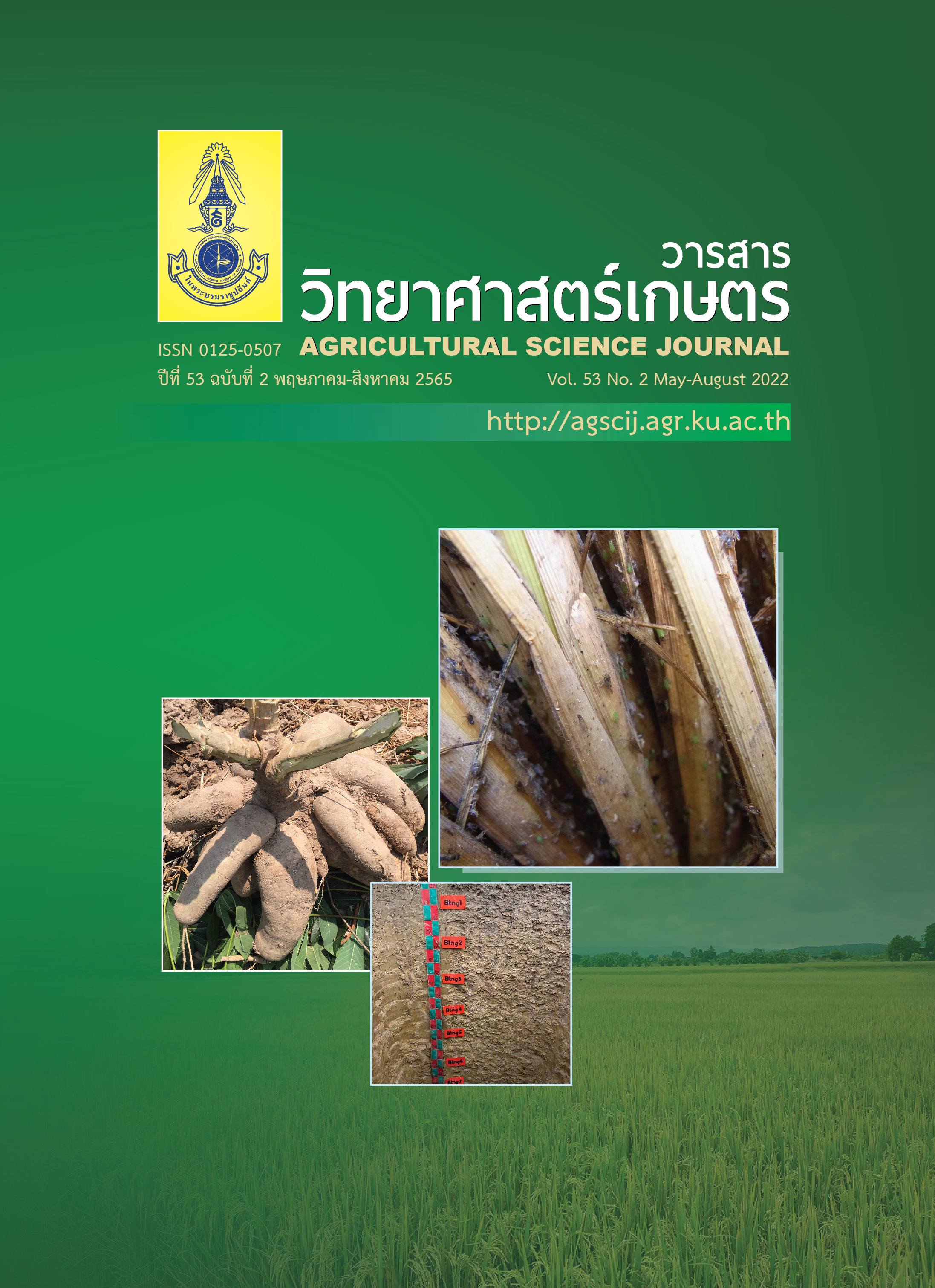ผลของปุ๋ยไนโตรเจน ฟอสฟอรัส และโพแทสเซียมที่ใส่ต่อเนื่องสามปีต่อมันสำปะหลังที่ปลูกในชุดดินยโสธร
Main Article Content
บทคัดย่อ
การเพิ่มผลผลิตมันสำปะหลังจำเป็นต้องใช้ปุ๋ยในปริมาณที่เหมาะสมจึงได้ทำการศึกษาการตอบสนองของมันสำปะหลังพันธุ์ห้วยบง 80 ต่อปุ๋ยเคมีในชุดดินยโสธรต่อเนื่อง 3 ฤดูกาลเพาะปลูก ใช้แผนทดลองแบบบล็อกสุ่มสมบูรณ์จำนวน 8 ตำรับการทดลอง คือ ใส่ปุ๋ย 20:10:20 กิโลกรัม N:P2O5:K2O ต่อไร่ (NPK) ใส่ปุ๋ยตำรับ NPK แต่ไม่ใส่ไนโตรเจน (–N) ฟอสฟอรัส (–P) และโพแทสเซียม (–K) ใส่ปุ๋ยในตำรับ NPK แต่ลดปุ๋ยไนโตรเจน (–½N) ฟอสฟอรัส (–½P) และโพแทสเซียม (–½K) ลงครึ่งหนึ่ง และไม่ใส่ปุ๋ยเคมี (–NPK) ผลการศึกษา พบว่า ตำรับ –NPK ให้ผลผลิตมันสำปะหลังทุกส่วนต่ำสุดอย่างมีนัยสำคัญทางสถิติในทุกฤดูปลูก (P < 0.01) ผลผลิตหัวมันสำปะหลังสด (3.32–6.17 ตันต่อไร่) และผลผลิตแป้ง (0.89–1.71 ตันต่อไร่) มีค่าสูงสุดไม่แตกต่างกันทางสถิติเมื่อมีการใส่ปุ๋ย ยกเว้นตำรับ –K ที่ให้ผลไม่แตกต่างจากตำรับ –NPK ในฤดูปลูกที่ 1 ในฤดูปลูกที่ 2 พบว่า ตำรับ –N ให้ผลผลิตต่ำไม่แตกต่างกับตำรับ –K และ –NPK ส่วนตำรับ NPK, –½N และ –½P ให้ผลผลิตหัวมันสำปะหลังสดและผลผลิตแป้งสูงสุด (P < 0.01) ในพิสัย 3.66–4.39 และ 1.09–1.25 ตันต่อไร่ ตามลำดับ การใส่ปุ๋ยเคมีตำรับ NPK ทำให้มีการดูดใช้ธาตุอาหารหลักในส่วนต่าง ๆ ของมันสำปะหลังส่วนใหญ่สูงสุด โพแทสเซียมสูญเสียไปกับผลผลิตมากที่สุด ดินหลังเก็บเกี่ยวมันสำปะหลังในฤดูปลูกที่ 3 มีไนโตรเจนรวมและโพแทสเซียมที่เป็นประโยชน์สูงสุดเมื่อใส่ปุ๋ยที่มีธาตุอาหารนั้นในอัตราสูงสุด (P < 0.01) แต่ฟอสฟอรัสที่เป็นประโยชน์ในดินไม่มีความสัมพันธ์กับปุ๋ยฟอสฟอรัสที่ใส่ แสดงให้เห็นว่า การใส่ปุ๋ยตำรับ NPK หรือการลดปริมาณธาตุอาหารหลักใดลงครึ่งหนึ่งต่างเป็นอัตราที่เหมาะสมในการเพิ่มผลผลิตมันสำปะหลังที่ปลูกในดินนี้
Article Details

อนุญาตภายใต้เงื่อนไข Creative Commons Attribution-NonCommercial-NoDerivatives 4.0 International License.
เอกสารอ้างอิง
Anusontpornperm, S., S. Nortcliff and I. Kheoruenromne. 2009. Interpretability comparison between soil taxonomic and fertility capability classification units: a case of some major cassava soils in northeast Thailand. Kasetsart J. (Nat. Sci.) 43: 9–18.
Bray, R.H. and L.T. Kurtz. 1945. Determination of total organic and available forms of phosphorus in soil. Soil Sci. 59: 39–45.
Byju, G. and G. Suja. 2020. Mineral nutrition of cassava. Adv. Agron. 159: 169–235.
Cuvaca, I.B., N.S. Eash, D.M. Lambert, F.R. Walker and W. Rustrick. 2017. Nitrogen, phosphorus, and potassium fertilizer effects on cassava tuber yield in the coastal district of Dondo, Mozambique. Afr. J. Agric. Res. 12(42): 3112–3119.
Duangpatra, P. 1988. Soil and climatic characterization of major cassava growing areas in Thailand, pp. 157–184. In R.H. Howeler and K. Kawano, eds. Cassava Breeding and Agronomy Research in Asia. Proc. the 2nd Regional Cassava Workshop, 26–28 October 1987, Rayong, Thailand.
Ezui, K.S., A.C. Franke, A. Mando, B.D.K. Ahiabor, F.M. Tetteh, J. Sogbedji, B.H. Janssen and K.E. Giller. 2016. Fertilizer requirements for balanced nutrition of cassava across eight locations in West Africa. Field Crop Res. 185: 69–78.
Havlin, J.L., J.D. Beaton, S.L. Tisdale and W.L. Nelson. 2005 Soil Fertility and Fertilizers: An Introduction to Nutrient Management. Prentice Hall, Inc., New Jersey, USA.
Howeler, R.H. 1991. Long term effect of cassava cultivation on soil productivity. Field Crop Res. 26(1): 1–18.
Howeler, R.H. 1996. Mineral nutrition of cassava, pp. 110–116. In E.T. Craswell, C.J. Asher and J.N. O’Sullivan, eds. Mineral Nutrient Disorders of Root Crops in the Pacific. Proc. Workshop, 17–20 April 1995, Nuku alofa, Kingdom of Tonga.
Howeler, R.H. 2002. Cassava mineral nutrition and fertilization, pp. 115–147. In R.J. Hillocks, J.M. Thresh and A.C. Bellotti, eds. Cassava: Biology, Production and Utilization. CABI, New York, USA.
Howeler, R.H. 2012. Diagnosis of nutritional problems of cassava, pp. 305–320. In R.H. Howeler, ed. The Cassava Handbook. A Reference Manual Based on the Asian Regional Cassava Training Course, Thailand. Centro Internacional de Agricultura Tropical (CIAT), Cali, Colombia.
Howeler, R.H. 2017. Addressing nutritional disorders in cassava cultivation, pp. 301–330. In C. Hershey, ed. Achieving Sustainable Cultivation of Cassava. Cultivation Techniques. Vol. 1. Burleigh Dodds Science Publishing, Cambridge, UK.
Howeler, R.H. and L.F. Cadavid. 1990. Short-and long-term fertility trials in Colombia to determine the nutrient requirements of cassava. Fertil. Res. 26: 61–80.
Jackson, M.L. 1965. Soil Chemical Analysis: Advanced Course. Department of Soils, University of Wisconsin, Wisconsin, USA.
Johnson, C.M. and A. Ulrich. 1959. Analytical methods for use in plant analysis, pp. 26–78. Bulletin of the California Agricultural Experiment Station No. 766. Berkeley, California, USA.
Mengel, K. and E.A. Kirkby. 1987. Principles of Plant Nutrition. 4th edition. International Potash Institute, Bern, Switzerland.
National Soil Survey Center. 1996. Soil Survey Laboratory Methods Manual. Soil Survey Investigations Report No. 42, Version 3.0. Natural Conservation Service, United States Department of Agriculture, USA.
Nguyen, H., J.J. Schoenau, D. Nguyen, K. Van Rees and M. Boehm. 2002. Effects of long-term nitrogen, phosphorus, and potassium fertilization on cassava yield and plant nutrient composition in North Vietnam. J. Plant Nutr. 25(3): 425–442.
Obigbesan, G.O. 1977. Investigations on Nigerian root and tuber crops: effect of potassium on starch yield, HCN content and nutrient uptake of cassava cultivars (Manihot esculenta). J. Agric. Sci. 89(1): 29–34.
Phun-iam, M., S. Anusontpornperm, S. Thanachit and I. Kheoruenromne. 2018. Yield response of cassava Huay Bong 80 variety grown in an Oxyaquic Paleustult to cassava starch waste and nitrogen fertilizer. Agr. Nat. Resour. 52(6): 573–580.
Puengkasem, K., S. Anusontpornperm, S. Thanachit, I. Kheoruenromne and P. Petprapai. 2018. Effect of rice husk ash and potassium on soil properties and cassava, Huay Bong 80 variety, grown in Satuk soil series. Khon Kaen Agr. J. 46(5): 911–920. (in Thai)
Sittibusaya, C. 1996. Strategies of Developing Fertilizer Recommendations for Field Crops. Department of Agriculture, Ministry of Agriculture and Cooperatives, Bangkok, Thailand.
Thomas, G.W. 1982. Exchangeable cations, pp. 159–165. In A.L. Page, ed. Methods of Soil Analysis. Part 2. Chemical and Microbiological Properties. 2nd edition. Agronomy No. 9. American Society of Agronomy, Inc., Soil Science Society of America, Inc., Madison, Wisconsin, USA.
Uwah, D.F., E.B. Effa, L.E. Ekpenyong and I.E. Akpan. 2013. Cassava (Manihot esculenta Crantz.) performance as influenced by nitrogen and potassium fertilizers in Uyo, Nigeria. J. Anim. Plant Sci. 23(2): 550–555.
Wargiono, J., S.H. Kushartoyo and B. Guritno. 1998. Recent progress in cassava agronomy research in Indonesia, pp. 307–330. In R.H. Howeler, ed. Cassava Breeding, Agronomy and Farmer Participatory Research in Asia. Proc. the 5th Regional Workshop, 3–8 November 1996, Hainan, China.
Weil, R.R. and N.C. Brady. 2017. The Nature and Properties of Soils. 15th edition. Pearson, Massachusetts, USA.


